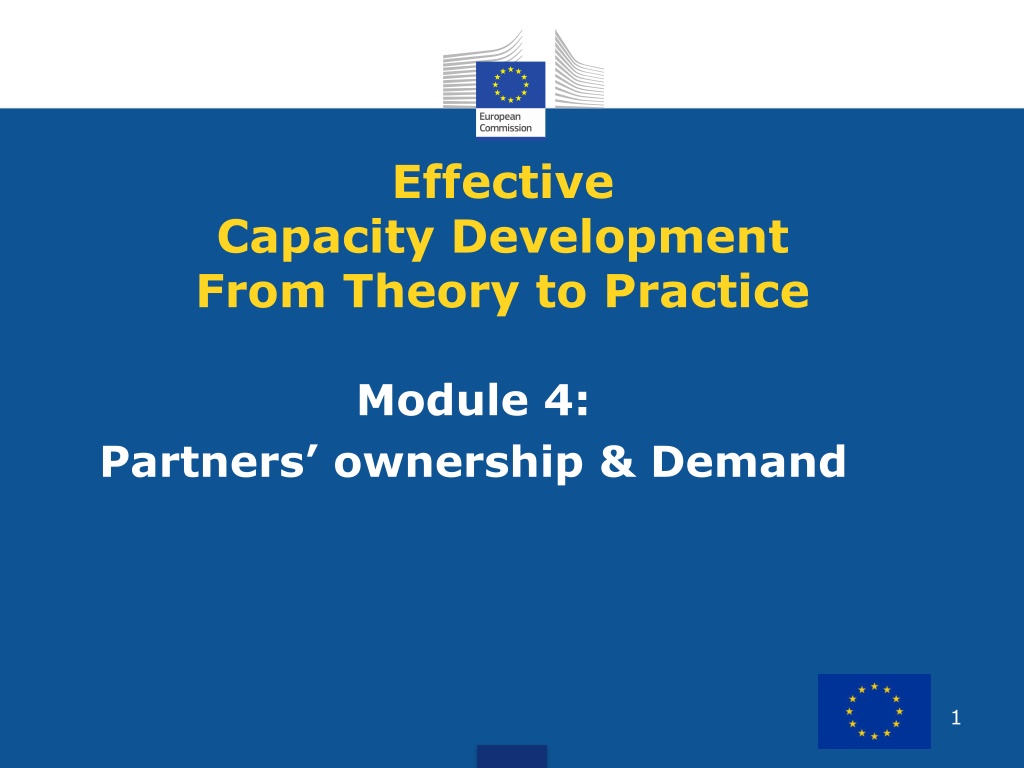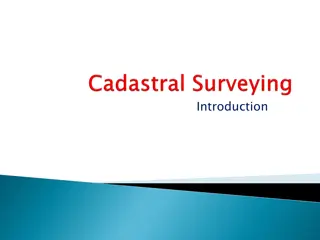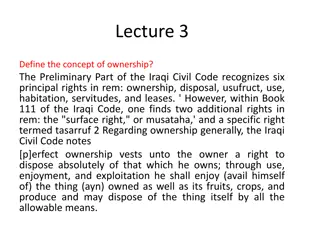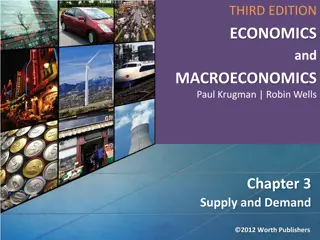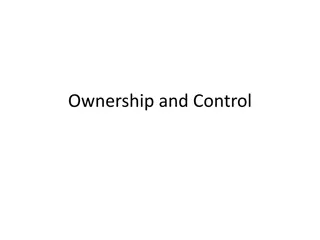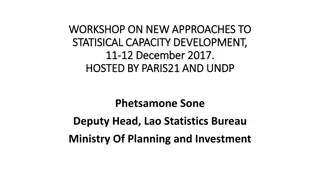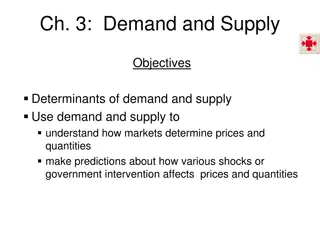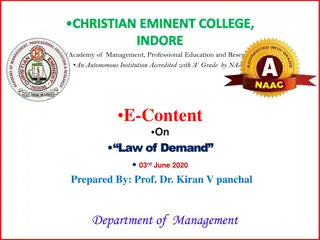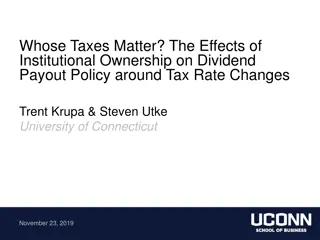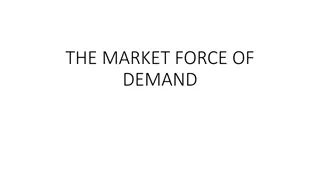Understanding Partner Ownership and Demand in Capacity Development
This module delves into the significance of ownership in capacity development (CD) initiatives, highlighting challenges faced and solutions. It emphasizes the importance of partner commitment and ownership to drive successful change processes. The content explores various perspectives on ownership and demand, essential for sustainable and partner-led capacity development efforts.
Download Presentation

Please find below an Image/Link to download the presentation.
The content on the website is provided AS IS for your information and personal use only. It may not be sold, licensed, or shared on other websites without obtaining consent from the author. Download presentation by click this link. If you encounter any issues during the download, it is possible that the publisher has removed the file from their server.
E N D
Presentation Transcript
Effective Capacity Development From Theory to Practice Module 4: Partners ownership & Demand 1
This Module Discusses the importance of ownership in a CD context Reflects on typical challenges encountered and how these may be addressed Examines ownership from three perspectives
CD Quality grid requirement: 2. Adequate demand, commitment and ownership from the country partners 2.1 How have key stakeholders demonstrated demand for CD, beyond reacting to proposals from the EU or consultants? 2.2 How have the country partners led or participated in the design of CD support, beyond formal consultation and endorsement of proposals and other requirements?
Why Ownership & Demand are Important Success depends on partner ownership of and commitment to (i) change process and (ii) any proposed support EU support in absence of ownership and commitment will not work: It can facilitate but not lead change Partners must play an adequate role in each step of project cycle from identification to implementation and review of CD support, as custodians of proposed change Focus first on what partner will do, second on possible external contribution.Ideally, partner identifies needed support and comes to the EC to discuss possible support Capacity Development a core responsibility for leaders of any organisation a permanent agenda item
capacityX Are wrongly assumed to lead to Donor driven inputs Sustainable Sustainable capacity Partner led inputs May lead to 5
A good design for CD Support Is known, owned and supported by partners and stakeholders Can overcome resistance from those who may stand to lose Not just a donor formatted project design document But good design is not sufficient ownership throughout the life of an intervention, needs to be monitored and tested
Challenges On Partner Side fragmented and contested ownership weakly articulated and implicit ownership New faces, new agendas, poor institutional memory Ownership in words, but not sufficiently in action On Donor Side Design process rushed and consultant-driven Free good syndrome especially vis TC salesmanship and competing DP agendas and ideas New faces, new agendas, poor institutional memory Isomorphic Mimicry and Institutional Ventriloquism
Moving towards ownership Ownership sits on a continuum between fully donor driven and fully country owned Levels of ownership will vary according to changing circumstances, personnel involved, and the different levels and places in an organisation or sector All processes should support working towards full country ownership Fully country owned Fully donor driven Partner owned and partner led are different! 8
Dimensions of Ownership Change Readiness Practical Ownership Demand for external support
Change Readiness Purpose is to judge the depth and extent of ownership of proposed change: among different stakeholders involved over life of a programme ..never static
Three criteria for change readiness (1) Is there a Vision for change? is it appealing, realistic and worth the effort? (Does it suggest where we want to be ) (2) Is there adequate support for the vision? extent to which support for change is owned among external and internal stakeholders. Who would likely support or resist? (3) Is there change management capacity? is there the capacity to lead and run change process and do people have confidence in that capacity (political, technical, outreach, financial)
Or put differently: Conditions for change to happen If D + P + V = If D + P only = - Degree of Dissatisfaction (D) + Change will happen Risk of confusion - Adequacy of change process (P) + If D + V only = If P + V only = - Appealing vision (V) Likely Anxiety and frustration Change remains in pending tray Must be greater than cost of change
Practical Ownership - criteria Who brings issue to table? There must be a degree of initiative from country stakeholders to address capacity (do donors create an environment for ownership) Best for partners to select policies, actions and priorities based on own assessment even if technically not perfect Who assesses options and scenarios? How solid is the support behind the proposal? Extent to which there is evidence of building a constituency for change among wider group of stakeholders How engaged are senior managers in process? Devil in detail how far are managers able to visualise and articulate what to achieve and how to get there How do we relate Do partners and DPs communicate beyond the formal settings; is there mutual trust?
Demand for External Support Risk Demand often low, leading to un-owned and supply-driven assistance with little impact on change and indicative of poor ownership Exacerbated when a free good no opportunity cost Risk Mitigation Focus discussions on what country partners can do for themselves, before considering possible support Make costs of alternative forms of support transparent Be mindful of salemanship Adequate involvement of partners in selection, and management of external inputs Mutual accountability for results; resolving triangular affair
Balance the three- way relationship Customer? Client? Beneficiary Partner? Stakeholder? Employer? Local Organisations Doer? TA Donor Middleman? Mediator? Facilitator? Controller? Spy? Employer? Stakeholder? Customer? Partner? Benefactor?
Conclusion Playing a facilitating or supportive role is key to fostering partner-owned and partner-led change And this means investing in relationships There are likely to be tensions between adopting this role and pressure to disburse and show results. Procedures might also act against favouring a facilitating role An operational dilemma that needs to be continuously monitored and managed AE principles remain relevant; harmonisation, alignment, coordinated TC, country systems support
Exercise - Partner demand and ownership in your programmes 1. Is your programme fitting in the current context and the current levels of capacity? How do you know? 2. Is there sufficient dissatisfaction with the current situation? 3. Is there a vision for change? 4. If yes, is this vision widely supported among stakeholders? 5. Is there sufficient change management capacity? Achievements ------ Improvement needs
